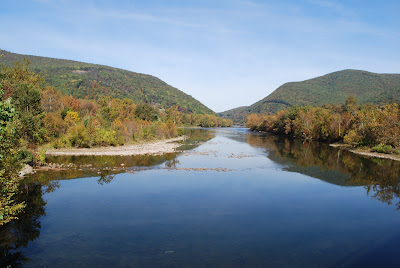
New River near Narrows, Virginia, October 13 2008. Photo by Valerie Turner.
Exam on Wednesday will start promptly at 6pm. Andy Dolloff will present his findings on the "History, habitat, chemistry, and catastrophe -- setting the stage for watershed restoration"
Here are some sample questions to remind you what we've been studying since early October.
What are the major principles of the natural flow paradigm? As a paradigm, how do you imagine this being applied to prescribing instream flows for various ecological flow components? Provide examples from San Pedro River, Arizona, Apalachicola River, Florida, Savannah River, Georgia-South Carolina, or other river.
In addressing the spatial connectivity of stream fishes, what are the common riverscape principles for effective research and management. Suggest how you might apply these principles to the study of American eel populations in the eastern USA.
Ecologists have identified the self-thinning rule, a reduction in density of a cohort of organisms due to intraspecific competition for a limiting resource as mean body size. In what type of stream fishes has this rule been demonstrated? How would you demonstrate the existing of a self-thinning rule in a stream minnow? How would you apply this rule to the management of stream habitats?
Recent evidence indicates that a Pacific Inter-decadal Climate Oscillation occurring at 20- to 30-year intervals in the North Pacific Ocean not only affects sea temperatures and drives salmon production but also changes climate over large areas of the North American continent and streamflow in major river basins from Alaska to California (Mantua et al. 1997 Bulletin of the American Meteorological Society 78: 1069–1079). Comment on how these finding relate to the ability of stream habitat managers to rehabilitate and restore stream habitats. How does this finding alter your standards and criteria for defining ecologically successful stream restoration?
What are habitat suitability criteria? How are they developed? How are they applied? What are the sources of uncertainty in habitat suitability criteria? How would you estimate the magnitude of uncertainty? Give one example of how you might use suitability criteria in directing stream rehabilitation and conservation activities.
A group of Ichthyology students sampled stream fishes at 200 locations in the western tributaries of the James River of Virginia using a variety of techniques and measuring habitat characteristics in each sampling reach. Would you expect the collections of fish assemblages to vary among locations? If so, what local habitat features might best explain the variation? Describe factors that may contribute to annual variation in the abundance and composition of these fish assemblages.
Two simple metrics are used to describe streamflow, Froude number and Reynolds number. Define these numbers, how they were derived and how they are measured. What is difference? Give an example of how these differ among visually defined habitat units or habitats selected by a particular stream animal.
Define shear force and how it is derived. What fluvial processes are influenced by shear force. How does shear force differ from critical shear force?
Instream flow and environmental flow – what do these terms mean? What are the basic approaches for prescribing these?
You are tasked with developing a new instream flow policy for the state of Nowhere, USA. Describe at least three key elements of your policy and how they would differ from current appropriate water doctrines.
Imagine a riverine segment with a meandering single channel pattern with extensive point bar development and heavily vegetated riparian corridor. Sketch the segment in planform (~25-30 channel widths) and identify areas of migrating point bars, even-aged riparian vegetation, locations of pools and riffles, and sorted gravel deposits. Sketch hypothetical cross sections for specific pools, riffles, runs, and glides and expected longitudinal bottom profile and bankfull elevations.
To develop environmental flows Richter et al. (2006 River Research and Applications) propose a five-step process includes: (1) an orientation meeting; (2) a literature review and summary of existing knowledge about flow-dependent biota and ecological processes of concern; (3) a workshop to develop ecological objectives and initial flow recommendations, and identify key information gaps; (4) implementation of the flow recommendations on a trial basis to test hypotheses and reduce uncertainties; and (5) monitoring system response and conducting further research as warranted. A range of recommended flows are developed for the low flows in each month, high flow pulses throughout the year, and floods with targeted inter-annual frequencies. How do they proposed developing the recommended flows without site-specific environmental studies? What are the strengths, weaknesses, and sources of uncertainty in this approach?
Stream restoration projects often involve bank treatments and streambed treatments to re-establish a vigorous riparian zone. In addition to providing shade and inputs of leaf fall, what other benefits would this provide to stream ecosystems?
“Being deeply learned and skilled, being well trained and using well spoken words; This is good luck” Buddha

No comments:
Post a Comment